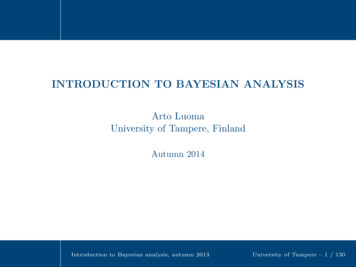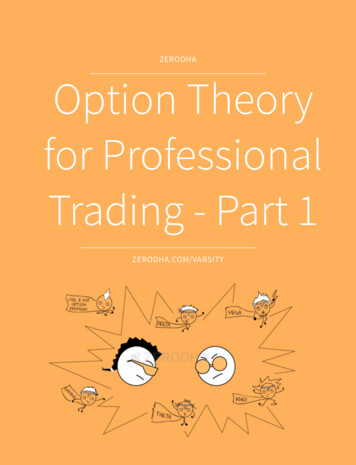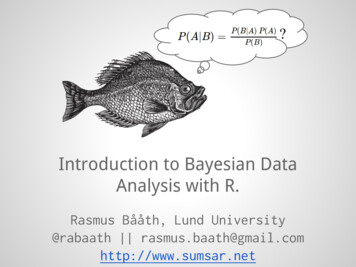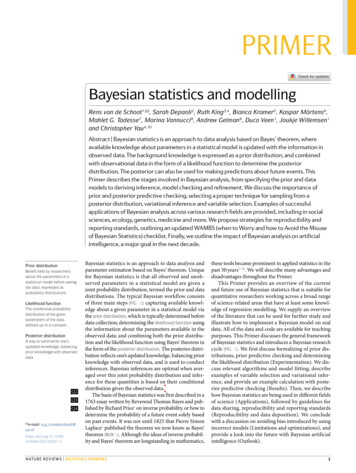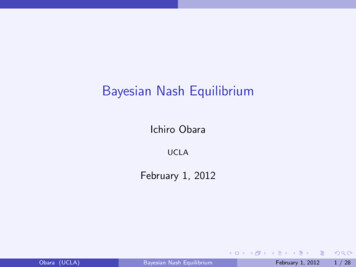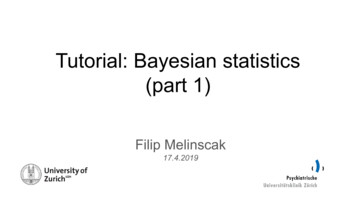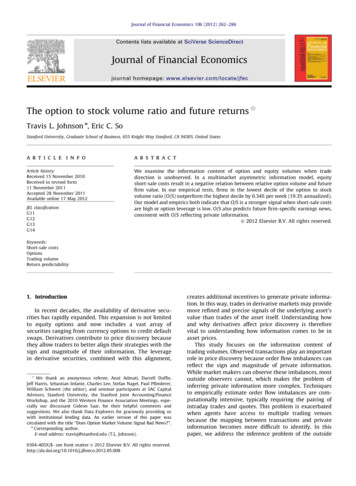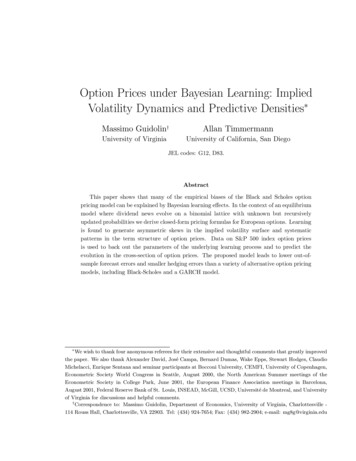
Transcription
Option Prices under Bayesian Learning: ImpliedVolatility Dynamics and Predictive Densities Massimo Guidolin†Allan TimmermannUniversity of VirginiaUniversity of California, San DiegoJEL codes: G12, D83.AbstractThis paper shows that many of the empirical biases of the Black and Scholes optionpricing model can be explained by Bayesian learning effects. In the context of an equilibriummodel where dividend news evolve on a binomial lattice with unknown but recursivelyupdated probabilities we derive closed-form pricing formulas for European options. Learningis found to generate asymmetric skews in the implied volatility surface and systematicpatterns in the term structure of option prices. Data on S&P 500 index option pricesis used to back out the parameters of the underlying learning process and to predict theevolution in the cross-section of option prices. The proposed model leads to lower out-ofsample forecast errors and smaller hedging errors than a variety of alternative option pricingmodels, including Black-Scholes and a GARCH model. We wish to thank four anonymous referees for their extensive and thoughtful comments that greatly improvedthe paper. We also thank Alexander David, José Campa, Bernard Dumas, Wake Epps, Stewart Hodges, ClaudioMichelacci, Enrique Sentana and seminar participants at Bocconi University, CEMFI, University of Copenhagen,Econometric Society World Congress in Seattle, August 2000, the North American Summer meetings of theEconometric Society in College Park, June 2001, the European Finance Association meetings in Barcelona,August 2001, Federal Reserve Bank of St. Louis, INSEAD, McGill, UCSD, Université de Montreal, and Universityof Virginia for discussions and helpful comments.†Correspondence to: Massimo Guidolin, Department of Economics, University of Virginia, Charlottesville 114 Rouss Hall, Charlottesville, VA 22903. Tel: (434) 924-7654; Fax: (434) 982-2904; e-mail: mg8g@virginia.edu
1. IntroductionAlthough Black and Scholes’ (1973) formula remains the most commonly used option pricingmodel in financial markets, a large literature has documented its strong empirical biases. Mostcommonly, such biases are associated with the appearance of systematic patterns (smiles orskews) in the implied volatility surface produced by inverting market prices and solving for theunknown volatility parameter (e.g. Rubinstein (1985, 1994) and Dumas, Fleming and Whaley(1998)). Implied volatility also appears to be systematically related to the term structure ofoption contracts (Das and Sundaram (1999)).Several pricing models have been proposed to overcome these problems. These includestochastic volatility (Hull and White (1987), Wiggins (1987), Melino and Turnbull (1990),Heston (1993)) and GARCH models (Duan (1995), Heston and Nandi (2000)); models withjumps in the underlying price process (Merton (1976)); jump-diffusion models (Ball and Torous(1985), Amin (1993)); and models incorporating transaction costs (Leland (1985)). Bakshi, Caoand Chen (1997) summarize the empirical performance of these models. Most option pricingmodels fail to improve significantly on the empirical fit of the Black-Scholes (BS) model and, bymodifying the stochastic process followed by the underlying asset price, do not provide a directeconomic explanation for the systematic shortcomings of BS. Nevertheless, this literature hascontributed significantly to our understanding of the requirements of an option pricing modelthat can fit observed data.In this paper we relax the key assumption underlying the BS model of full information aboutthe stochastic process that drives fundamentals. More specifically, we assume that fundamentalsevolve on a binomial lattice with ‘up’ and ‘down’ probabilities that are unknown to investorswho update their probability estimates using Bayes’ rule. The underlying asset price processis determined by embedding the learning mechanism in an equilibrium model. In equilibrium,asset prices reflect all possible future probability distributions of the parameter estimates andthere are no expected gains from implementing trading strategies based on the unfolding ofestimation uncertainty.While there are now many papers studying the asset pricing effects of learning,1 the onlyother studies that explicitly consider its derivative pricing implications appear to be David andVeronesi (1999) and Yan (2000). In an important contribution, David and Veronesi (1999)have investors facing a filtering problem which leads them to update the probability of whichof two states fundamentals are currently in. In their model, shocks to fundamentals are drawnfrom a non-Gaussian mixture distribution and hence the BS model is not obtained in the limiteven when there is full information about the state. In contrast, we assume that fundamentalsfollow a binomial process, whose limit is Gaussian. This allows us to isolate the effect of1E.g., Bossaerts (1995, 1999) and Timmermann (1993).1
investors’ recursive estimation of parameter values in a model that converges asymptoticallyto BS. Another difference is that we study the ability of the learning model to predict out-ofsample the evolution in the entire cross-section of option prices and to generate lower hedgingerrors than BS. The importance of such exercises for evaluating different option pricing modelshas recently been emphasized by Dumas et al. (1998). In Yan (2000) the unobservable rate ofgrowth of dividends follows a mean-reverting diffusion process. Again shocks to fundamentalsare drawn from a non-Gaussian mixture distribution, so that BS does not obtain under fullinformation,2 which makes it more difficult to extract the effects of recursive learning on optionprices. Yan presents calibrations which indicate that the model can generate a wide variety ofimplied volatility surfaces but presents no empirical estimates of the model’s fit and does notexplore the possibility of implying beliefs from observed asset prices.Our approach is also related to a large literature that infers the market’s probability beliefsfrom asset prices (Rubinstein (1994), Jackwerth and Rubinstein (1996), Aït-Sahalia and Lo(1998)) although our results explicitly incorporate the effect of investors’ beliefs on equilibriumprices. The assumption that the market updates its beliefs through Bayes rule adds a newaspect to this exercise and provides an understanding of the time-series dynamics of impliedvolatility surfaces.Simply replacing the assumption in the BS model of known ’up’ and ’down’ probabilitieswith Bayesian learning is found to generate biases similar to those observed in option prices.Consistent with recent empirical evidence (Aït-Sahalia and Lo (1998)), learning alters the shapeof the state price density perceived by investors by adding to tail probabilities. Furthermore,learning effects can generate implied volatility smiles as well as a variety of non-constant termstructures of implied volatility.3 By inverting the resulting model, we can infer the dynamicsof the parameters of the Bayesian learning scheme from data on S&P 500 index option prices.Independently of the time period over which theoretical option prices are matched with observedprices, we find that estimated parameters are remarkably stable over time and that our modelprovides a good in-sample fit, and especially an excellent out-of-sample performance in additionto generating smaller out-of-sample hedging errors than the BS model and various alternativesproposed in the literature (Dumas et al.’s (1998) ad hoc strawman and Heston and Nandi’s(2000) option NGARCH).The outline of the paper is as follows. Section 2 introduces the data set and briefly describessystematic biases in the BS option pricing model. Section 3 presents the binomial lattice modelunder full information and Bayesian learning is introduced in Section 4 which also derives2However Yan (2000, p. 22) shows that under log-utility a special version of BS that incorporates stochasticinterest rates and volatility obtains.3Das and Sundaram (1999) show that the most popular alternatives to BS – jump-diffusion and stochasticvolatility models – fail to simultaneously generate implied volatility smiles and term structures that match thecomplex features of the data.2
explicit formulae for European option prices. Section 5 characterizes the equilibrium effect oflearning on option prices and calibrates the option pricing model under learning so it can becompared to the data from Section 2. The parameters characterizing the maintained recursivelearning process are inferred from option prices in Section 6 and used to predict option pricesout-of-sample. Section 7 concludes.2. Biases in the Black-Scholes ModelThis section briefly outlines the systematic pricing biases in the BS option pricing model andthus serves as a benchmark for the empirical analysis. Our data set of option prices from theCBOE consists of weekly S&P 500 index option prices4 covering a five and a half year periodfrom June 1988 through December 1993 (a total of 30,461 observations) and is identical to theone used in Dumas et al. (1998).5 We explicitly take into account that the index pays outdaily dividends and adjust the reported index level by subtracting the present value of the cashdividends to be paid during the life of the option. We follow the same procedures for filteringthe data as in Aït-Sahalia and Lo (1998) and thus differ slightly from Dumas et al. (1998) inthe application of some exclusion criteria. First, we eliminate options with fewer than 6 andmore than 200 days to expiration.6 Second, since it is well known that in-the-money optionsare thinly traded, their prices are notoriously unreliable and are thus discarded from the dataset. Out-of-the-money and near-at-the-money put prices are translated into call prices usingput-call parity. All information contained in liquid put option prices has thus been extractedand converted into call prices. The remaining put options are discarded from the data setwithout loss of information. The application of these criteria reduces the size of the sample toa total of 9,679 observations.72.1. Implied Volatility SurfacesInitially we confirm the existence of a systematic skew in the relationship between BS impliedvolatility and moneyness. Figure 1 plots the implied volatility surface against moneyness for4As stressed by Rubinstein (1994), the market for S&P 500 index options on the CBOE provides a case studywhere the conditions required by BS seem to be well approximated in terms of volumes, continuity of the tradingprocess and hedging opportunities.5We thank Bernard Dumas for making this data set available to us. Data are sampled on Wednesdays andonly options with bid/ask price quotes between 2:45 and 3:15 p.m. (CST) are used. Wednesdays are chosen inorder to minimize the incidence of the number of holidays. Option prices correspond to bid/ask midpoints. Therisk-free rate is proxied by the average of bid and ask discounts reported in the Wall Street Journal. Daily cashdividends are collected from the S&P 500 Information Bulletin.6Dumas et al. (1998) exclude all contracts with more than 100 days to expiration.7One observation had to be excluded since it violated the lower bound condition and led to a negative impliedvolatility.3
the six December maturities represented in our data sample.8 For most days in the sampleperiod, the curve relating BS implied volatilities to the strike price is skewed. This is of courseinconsistent with the maintained assumption of a constant diffusion in the BS model.2.2. Term Structure of Implied VolatilityThe data also reveals a systematic term structure in implied volatilities. Using three alternativevalues of moneyness over the period Jan. 18, 1993 to Jan. 25, 1993, Figure 2 shows that theimplied volatilities of at-the-money options and options with moneyness less than one increasewith time to expiration. For in-the-money options the pattern is somewhat weaker: some daysimplied volatility is an increasing and convex function of time to expiration; other days impliedvolatility is a concave function of moneyness and occasionally the pattern is constant or evendeclining.2.3. State Price DensitiesRecently Rubinstein (1994) and Jackwerth and Rubinstein (1996) proposed to extract stateprice densities (SPD) from implied binomial trees. This is another powerful procedure fordemonstrating biases in the BS model whose assumption is that the state price density is lognormal. Figure 3 shows the SPD inferred from option contracts with at least 7 calendar days toexpiration and averaged across calendar days and maturities (a total of 765 estimated SPDs).To ensure that SPDs on different days are comparable, all plots use standardized logarithmicreturns. Particularly important in economic terms is the tail behavior of the SPD since thismay provide information about the jump risk expected by markets, cf. Bates (1991). Thereforewe plot in the bottom of Figure 3 the estimated tail behavior of the average SPD.Compared to the lognormal benchmark, the SPD is clearly leptokurtic. Market participantsassign high value to future ‘extreme’ outcomes that under a lognormal SPD would receive amuch smaller state price. To demonstrate this point, Table 1 compares the no-arbitrage pricesof a state-contingent asset paying off one dollar when the S&P 500 returns exceed (in absolutevalue) a certain number of standard deviations of returns under the estimated SPDs versusunder a lognormal benchmark. Higher prices for tail-contingent securities reflect the fact thatunder the estimated SPDs the market assigns a much higher risk-neutral price to a dollar paidout in either crash or strongly bullish states of the world.8The finding of skews in implied volatility is generic and holds across different maturities.4
3. Asset Prices under Full InformationThe empirical findings reported in Section 2 confirm the presence of systematic biases in theBS model and suggest that a more general option pricing model is required. This sectioncharacterizes option prices in a full information equilibrium model which has the BS model asa limiting case and sets up a benchmark from which to evaluate option pricing biases. Learningis introduced in Section 4.3.1. Fundamentals on a Binomial LatticeOur starting point is a version of the infinite horizon, representative agent endowment economystudied by Lucas (1978). There are three assets: A one-period default-free, zero-coupon bondin zero net supply trading at a price of Pt and earning interest of rt (1/Pt 1); a stock tradedat a price of St whose net supply is normalized at 1; and a European call option written on thestock with τ T t periods to expiration, strike price K and current price Ct .9The stock pays out an infinite stream of real dividends {Dt k } k 1 . Dividends are perishableDt k and are consumed in the period when they are received. Dividend growth rates, gt k Dt k 11, follow a Bernoulli process that is subject to change m times in each unit interval. Withinthe interval [t, t τ ] dividends thus follow a v τ m-step binomial process. For each intervalthe dividend growth rate is gh with probability π or gl with probability 1 π:(gh with prob. πgt k 1 k 0, π (0, 1)(1)gl with prob. 1 πWithout loss of generality we assume that gh gl 1 so that dividends are non-negativeprovided Dt 0. This gives a standard recombining binomial tree similar to the one adopted byCox, Ross and Rubinstein (1979) for the underlying asset price process. qWe follow the literaturein normalizing theq parameters by the incremental time unit: 1 gh eσdtv, 1 gl (1 gh ) 1 ,dtand π 12 12 σµ dtv . As v 0, the distribution of dividends converges weakly to a geometricBrownian motion with constant drift and diffusion (µ, σ).To price assets we assume a perfect capital market. There are unlimited short sales possibilities, perfect liquidity, no taxes, no transaction costs or borrowing and lending constraints andmarkets are open at all the nodes of the binomial lattice where news on dividends are generated.9Dividends in our model really refer to all information on (cash and non cash) earnings produced by companiesin the stock index. David and Veronesi (2000) compare beliefs implicit in observed option prices and beliefs filteredout by a sensible definition of fundamentals (real earnings). They find that the two series are quite different,a sign that a much more complex notion of fundamentals than earnings or dividends is likely to be used byinvestors.5
The representative investor has power utilityu(Zt ) ½ Zt1 γ 11 γln Ztγ 1γ 1(2)where Zt is real consumption at time t. We focus on the case where γ 1; models with γ 1have the counter-intuitive property that stock prices decline when the probability of high growthof the fundamentals increases, see Abel (1988).10 The representative agent chooses bond, stock,and call option holdings to maximize the discounted value of expected future utilities derivedfrom consumption subject to a budget constraint:max sb,wt k}{Zt k ,wt kEt" Xβ k u(Zt k )k 0k 0#(3)sbsbSt k wt kPt k wt k 1(St k 1 Dt k 1 ) wt k 1,s.t. Zt k wt k1sbwhere β 1 ρ, ρ is the rate of impatience and wt kand wt krepresent the number of stocks11and bonds in the agent’s portfolio as of period t k.Standard dynamic programming methods yield the following Euler equations for stock andbond prices:St Et [Qt 1 (St 1 Dt 1 )]Pt Et [Qt 1 ](4) γ0Zt 1t 1 )is the pricing kernel defined as the product of the discountwhere Qt 1 β uu(Z0 (Z ) βZttfactor and the intertemporal marginal rate of substitution in consumption.Guidolin and Timmermann (2001) price the underlying stock and risk-free bond in thissetting subject to a transversality condition.12 For convenience, we state asset prices using the³10The restriction γ 1 is not as implausible as it might appear in the light of the voluminous literature that haseither estimated or used values of γ well above 1 in order to match known stylized facts concerning asset pricesand returns. The existing literature has in general performed these empirical exercises under the assumptionof full information rational expectations. Guidolin and Timmermann (2000) show that on a Bayesian learningpath, many stylized facts concerning asset prices (such as high volatility and serial correlation) can easily berationalized for γ 1. A referee also pointed out that in the framework of Abel (1999), an economy with leveragecan be well approximated by our endowment economy with the coefficient of relative risk aversion replaced bythe ratio between γ and the leverage index.11Since the call is a redundant asset which does not expand the set of attainable consumption patterns,option holdings do not enter into the program and the equilibrium stock and bond prices can be determinedindependently of the option price.12The transversality condition is:"Ã T!#Y im EtQt k St T 0.T k 16
transformed parameters gl (1 gl )1 γ 1 and gh (1 gh )1 γ 1.Proposition 1 (Guidolin and Timmermann (2001)) The full information rational expectations stock price is given by1 gl π(gh gl )St Dt ,ρ gl π(gh gl )while the full information bond price isPt (1 gl ) γ π [(1 gh ) γ (1 gl ) γ ].1 ρA property of the solution is that the stock price is homogeneous of first order in dividends and that the ex-dividend stock price follows the same binomial lattice {gh , gl , π, m} asdividends.13 This means that dividends and stock prices follow a stationary Markov chain.3.2. Option Prices under Full InformationPricing European calls and establishing the link to Black-Scholes is straightforward under fullinformation. This follows from noting that in our model (i) arbitrage opportunities are ruledout; (ii) markets are complete; (iii) ex-dividend stock prices inherit the binomial lattice structure{gh , gl , π, m} from dividends; (iv) although the underlying asset pays out cash dividends, theoption is European and early exercise is not possible. Therefore we can draw on the resultof Cox et al. (1979) that the price of a European option converges to the BS value providedthe parameters are suitably adjusted as the number of increments to the lattice per unit ofcalendar time goes to infinity. Let r be the risk-free rate, δ the dividend yield, and µ and σrespectively the (annual) mean and volatility of the dividend growth rate, while dt is an intervalof fixed calendar time (typically τ /252, supposing there are 252 trading days). The followingproposition restates this result and shows the mapping between the deep parameters of ourmodel and the BS inputs.Proposition 2 Suppose that the parameters have been scaled as follows:r³ 1 1 µ dt(m)(m)(m) 1σ dt/v(m) 1, 1 gl 1 gh,π gh e2 io2 σ vnhdt(m)(m)(m)ρ(m) (1 r) v (1 gl ) γ π(m) (1 gh ) γ (1 gl ) γ 1 0hio vndt(m)(m)(m)(1 r) (1 gl ) γ π(m) (1 gh ) γ (1 gl ) γ(m)δ 1. nhio vdt(m) 1 γ(m) 1 γ1 γ(m) (1 gl ) π(1 gl )(1 gh )13When combined with the result in Pliska (1997) that a multiperiod security markets model is complete if andonly if all possible sequences of single period models obtained by decomposing the binomial lattice are formedby complete models, it follows that the asset market in our model is complete and the call option is a redundantasset, as conjectured.7
Then as m , the price of the European call converges to its BS value:(m)CtBS St Φ(d1 )e δ dt e rdt KΦ (d2 )hi ¡ ³(m) 2ln SKt r δ (m) v 12 v ln(1 gh )d1 (m)v ln(1 gh ) d2 d1 v ln (1 gh )where v τ m and Φ(·) is the c.d.f. of the standard normal distribution.Proof. See Appendix A.As m , dtv goes to zero, and the binomial lattice converges weakly to a geometric Brownian motion with parameters (µ, σ), the distributional assumption required by BS in continuoustime.14 This proposition shows that the results of Cox et al. fully extend to our frameworkwhere dividends rather than stock prices are assumed to follow a binomial lattice. Notice, however, that while Cox et al. take the process for the underlying price as exogenous, we derive theunderlying stock price in an equilibrium model in which preferences matter. This result canalso be related to Stapleton and Subrahmanyam (1984) who value options in a general equilibrium model when markets are incomplete and the stock price evolves on a binomial lattice. Incontrast to Stapleton and Subrahmanyam, our model assumes that markets are complete, butthe exogenous binomial lattice process applies to dividends. Obviously in both cases preferencesaffect the equilibrium price of stocks as well as options. Since the BS option price is obtained inthe limit under full information, this model is ideally suited to discuss the origin of BS pricingbiases.4. Option Prices on a Learning PathIt is common in the option pricing literature to assume a given process for the underlyingasset price and then price the option as a redundant asset whose payoffs can be replicated in adynamic hedging strategy invested in the risky asset and a riskfree bond. The standard setupassumes that the asset price process is stationary and hence that there are no learning effects.Once learning is introduced, an equilibrium model for the underlying asset price is required.Suppose that the proportion of times dividends move up on the binomial lattice, π, isunknown to investors who recursively estimate it through the simple maximum likelihood esti14This point can also be shown by noting that as m, v the discrete state price density converges to atransformation of the lognormal:( 2 )¡ln (St ) r δ 12 [ln(1 gh )]2 v11 rτe f (St T ) e.exp 2πσ τ St T2v [ln(1 gh )]28
mator:πbt k,j Pm(t k) ji 1nm(t k) jI{m(t k) i gh } m(t k) jNm(t k) jj 0, 1, ., m 1(5)where I{m(t k) i gh } is an indicator function which is one when at the m(t k) i th stepof the lattice dividend growth is high, and is zero otherwise. ni denotes the number of highgrowth states recorded up to node i, while Ni is the total number of nodes since time t. Theindices m(t k) j (j 0, 1, ., m 1) take into account that learning happens on the binomialtree and not over calendar time. Investors are assumed to start out with prior beliefs {n0 , N0 }and update these through Bayes rule.Despite the presence of learning effects, the same features that simplified the solution of assetprices under full information are still in place: (i) consumption and dividends must coincidein general equilibrium; (ii) if markets are complete, investors form portfolio choices based onlyon the stock index and the bond; (iii) being redundant assets, options can be priced by noarbitrage, using the unique risk neutral probability measure. This can be used to prove thefollowing result:Proposition 3 Suppose that the stock price is homogeneous of degree one in the level of realdividends, that a transversality condition holds, and that ρ gh . Then the stock price underBayesian learning (BL) is vi X³ Xj nt , NtStBL Dt v imβi(1 gh )j (1 gl )i j Pr BLDt it i 1j 0 Dt ΨBLt (nt , Nt )³ j (1 gh )j (1 gl )i j Dt nt , Nt is given bywhere the posterior distribution Pr BLDt itPr BLtno µ i ¶ Qj 1 (n k) Qi j 1 (N n k)ttjk 0 t.Dt i nt , Nt Qi 1 k 0jk 0 (Nt k)The bond price under Bayesian learning is γ bt [(1 gh ) γ (1 gl ) γ ]bt β(1 gt 1 ) γ (1 gl ) π.PtBL (bπt ) E1 ρProof. See Appendix A.Proposition 3 has several implications. First, the price-dividend ratio is no longer constantbt . Dividend changes acquire a selfand depends (through nt and Nt ) on the current estimate πenforcing nature: Positive dividend shocks lead to an increase in the stock price not only throughthe standard proportional effect, but also through the revision of the dividend multiplier.9
Although dividend yields are now time-varying, in principle binomial methods could stillbe used to obtain the no-arbitrage price of European options on flexible trees (see, e.g., Chriss(1997)). However, risk-free rates in our equilibrium model are not only time-varying, but alsoa function of the state variable πbt k . Furthermore, the interest rate process cannot be characterized as a recombining lattice. The value today of one dollar in the future depends not onlyon the number of high and low growth states occurring between today and the future, but alsoon their sequence.15 In other words, the appropriate discount factors become path-dependent.Since risk-free rates show up in the general risk-neutral valuation formula proved by Harrisonand Kreps (1979), the induced lattice for the call option also becomes non-recombining.16This path dependence means that no-arbitrage methods are more complicated in an equilibrium model with learning. Nevertheless, European call options on a stock index can still bepriced by employing a change of measure based on the perceived probabilities:Proposition 4 On a Bayesian learning path, the no-arbitrage price of a European call withtime-to-expiration τ and strike price K isCtBL (K, T, StBL ) vXj 0onnoBL,jj K PetBL St v nt , Ntmax 0, St vBL,j (1 gh )j (1 gl )v j StBL (1 gh )j (1 gl )v j ΨBLwhere v τ m, St vt v (nt j, Nt v)Dt ,15This can most easily be seen by comparing the value as of period t 1 of one dollar in period t 3 whenboth the high and low dividend growth rates occur. When high growth is followed by low growth we havei 1 hi 1hBLBL(bπ ut 1 )(bπ ud1 rt 21 rt 1t 2 ) 1 ρ(1 gl) γ (nt 1)(Nt 1)[(1 gh) γ (1 gl) γ ] 1 ρ(1 gl) γ (nt 1)(Nt 2)[(1 gh ) γ (1 gl ) γ ],nt 1where πb udb dut 2 Nt 2 πt 2 .When the sequence is reversed and low growth is followed by high growth, we gethi 1 hi 1BLBL1 rt 21 rt 1(bπ dt 1 )(bπ du t 2 )1 ρ1 ρ .nt 1[(1 gh ) γ (1 gl ) γ ](1 gl ) γ N[(1 gh ) γ (1 gl ) γ ]t 2 Taking the ratio of these two expressions and letting G (1 gh ) γ (1 gl ) γ , we have (1 gl ) γ ntNt 1nt (nt 1) 2) (nt 1)(Nt 1)G2 nt (Nt(N(1 gl ) γ G(Nt 1)(Nt 2)t 1)(Nt 2)2(n 1)(n 1)(2N 3)tgl ) 2γ (Nt 1)(NG2 (Ntt 1)(Ntt 2) (1 gl ) γ Gt 2)(1 gl ) 2γ (1 which in general differs from unity. For discounting purposes, the exact sequence of dividend realizations matters.16This is another important difference between our model and that of David and Veronesi (2000) which assumesmultiple states for dividends. In a Lucas-type general equilibrim model this will result in a state-dependentconsumption and risk-free rate process. However, David and Veronesi assume that the interest rate is fixed,suggesting that their results are of a partial equilibrium nature.10
jDt v (1 gh )j (1 gl )v j Dt (j 0, 1, ., v), andnonojjPetBL St v nt , Nt nt , Nt β v Pe Dt vProof. See Appendix A.ÃjDt vDt! γ Qv j 1µ ¶ Qj 1vk 0 (nt k) k 0 (Nt nt k) Qv 1jk 0 (Nt k)Under learning stock prices and beliefs no longer follow a stationary Markov chain, sinceboth the possible rates of change of the stock index and the (perceived) probabilities of thesechanges follow heterogenous Markov chains. The time-varying transition matrix that determineshow the risk-neutral distribution is updated is given byhift k (i 1, j 1)PeBL {Xt k 1 nt j Xt k nt i} M(6) ntNh (1 g ) γ ntRt k0. 0Rl (1 g l ) γ t khNt kNt k t k n 1N γ γtn 1t klh Rt k (1 g h ) Ntt k . 0 0Rt k (1 gl ) Nt k β . . . 000. 1ll 1 rt kis the gross interest rate factor that applies to the low growth state at t kwhere Rt ketc. Computation of the risk neutral probabilities now requires keeping track of the risk-freerate as we move along the dividend tree, reflecting the path-dependence in this variable.5. BS anomalies and learning effectsTo better understand the sense in which Bayesian learning can explain the biases in the BS modelwe establish conditions under which learning systematically affects option prices. Estimationuncertainty reduces the underlying asset price when investors ar
learning on option prices and calibrates the option pricing model under learning so it can be compared to the data from Section 2. The parameters characterizing the maintained recursive learning process are inferred from option prices in Section 6 and used to predict option prices out-of-sample. Section 7 concludes. 2. Biases in the Black .
